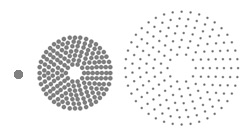Physicist Uses Mathematica to Develop an Optics Program at CERN
- Symbolic—solving equations and discovering general structures
- Graphic—solution visualization
- Programming—efficient list and matrix manipulation
- MathLink—linking to databases and custom interfaces
Geneva, Switzerland—Under the city, 100 meters deep, lies a particle accelerator with a 27-kilometer circumference used to study subatomic particles. By creating collisions at fantastic energies, it is possible to create particles that otherwise occurred only during the violence of the Big Bang.
A successful experiment requires precise control and focusing of relativistic beams. Bruno Autin, a physicist at CERN, used Mathematica to create an optics program to accomplish this delicate, yet complex task.
"Optics calculations involve heavy matrix manipulations and the solving of high-degree algebraic equations. The symbolic algebra capabilities of Mathematica are an ideal tool to calculate optical modules," Autin said.
Get started with Wolfram technologies, or work with us to apply computational expertise to your projects.
Questions? Comments? Get in touch: 1-800-WOLFRAM, or email us »























